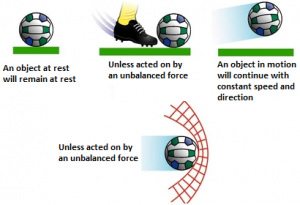Before 1600 century, it was believed that the natural state of the matter is the state of rest. Galileo, later on, suggested that it is not the property of the object to stop if it is in the motion but to resist any change in its motion
Newton later on came up with Newton’s First Law which states that is no external force is applied to an object and the object is at rest it will remain at rest and if the object is in motion it will continue to move with the same velocity.
First Law of motion: It is relates to the law of Inertia, it says that the body will remain in rest or in continue motion, unless some external force is applied on it.
It can also states that, everybody continues its state of rest or of uniform motion in a straight line, unless compelled by some external force to act otherwise. Inertia: It is the property of body by the virtue of which the body remains in rest or in continue motion, unless some external force is applied (or) anybody has tendency to oppose the external force applied due to Inertia. This also called as Law of Inertia.
Inertia: It is the property of body by the virtue of which the body remains in rest or in continue motion, unless some external force is applied (or) anybody has tendency to oppose the external force applied due to Inertia. This also called as Law of Inertia.
Consider an example that a book is lying on the table. Force of friction is present between the table and the book. Book is at rest and remains at rest until any force is applied to it. Suppose that force is applied to book in a direction which is opposite to the direction of the force of friction and applied force is greater than the force of friction.
Now, if we apply constant force, the book will move at constant velocity until we push harder and increase the applied force against the external forces acting on the book. When we increase the applied force the book will be accelerated. If the applied force is withdrawn, the book will come to rest and its velocity will become zero after covering some distance. Book will come to rest as the force to accelerate is applied by us, just opposite force to retardation is applied by the friction.
Newton’s First Law Formula: If the summation of all the applied forces to an object is zero, then the change of the velocity is zero.
If ∑ F = 0
Then,
\(\frac{dv}{dt}\,=\,0\)
Everyday applications of Newton’s First Law:
- Consider the case, if the gravitational force between the sun and other planets becomes zero, then what type of path would be followed by the planets.
All of the planets will start moving in straight line with zero acceleration or constant velocity.
- Consider a spaceship which is travelling in the space. Propulsion system in the spacecraft is required to change its velocity from one value to other. Now, if the propulsion system is shut down and remains off, the spacecraft will continue to move at the constant velocity without any acceleration and far away from any planets or other matter.
Newton’s First Law Example:
- Why do the dry leaves and fruits fall when we shake the tree?
When we shake the tree, the fruits and dry leaves remain at their position due to first law of motion, the inertia resist the motion, so, as the branches shake, they get detached from the tree.
- Passengers fall forward when bus suddenly stops. Why?
The passengers are in motion due to first law and as the bus suddenly stops due to inertia their upper body opposes the force and continues to remain in motion.
- How do you say that Mass is measure of inertia?
When we push the empty box, it easily moves from its position but when we apply the same force to the filled box, we are unable to move it, this is because the box is filled now and its mass has increased, so, the capacity of box to oppose the external force increases.
Thus, we conclude that the mass is measure of inertia, larger is the mass, larger is the capacity of the body to oppose external force and hence larger is inertia.
How to find the Newton’s First Law of Motion:
Example: A 1000kg spaceship travels in the vacuum of space at a constant speed of 500 m/sec. Ignoring any gravitational forces, what is the net force on the spaceship?
Solution: In a vacuum, there is no friction due to air resistance. Newton’s first law states that an object in motion stays in motion unless acted upon by a net force. Thus the spaceship will travel at the constant speed (zero acceleration) of 500 m/sec indefinitely and the net force on the spaceship must be zero.
Mathematically:
F = ma
F = (1000 kg) (0 m/s²) = 0 N
